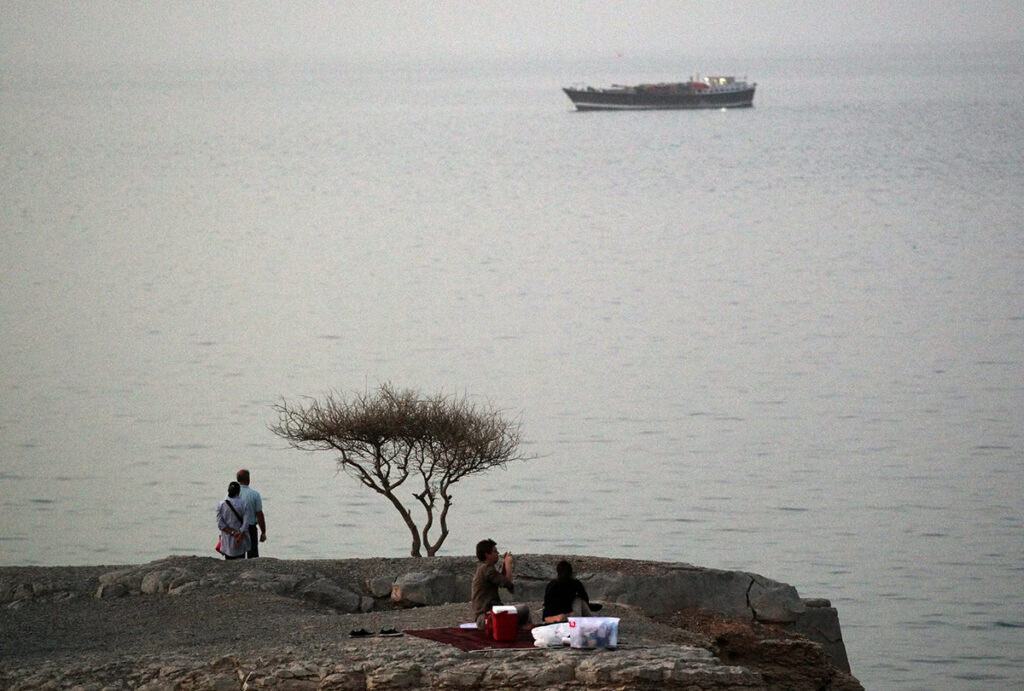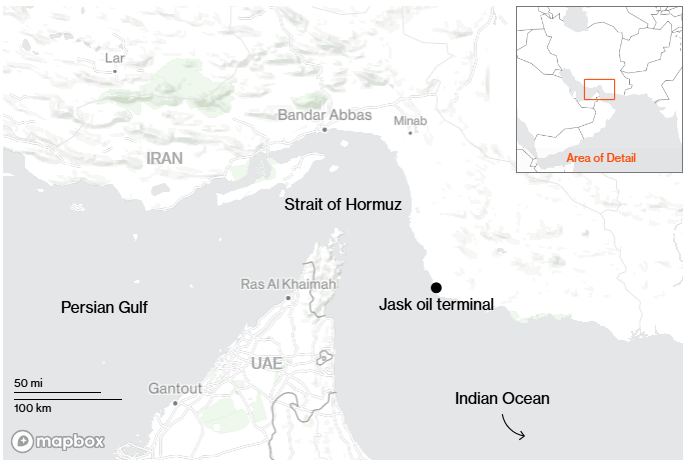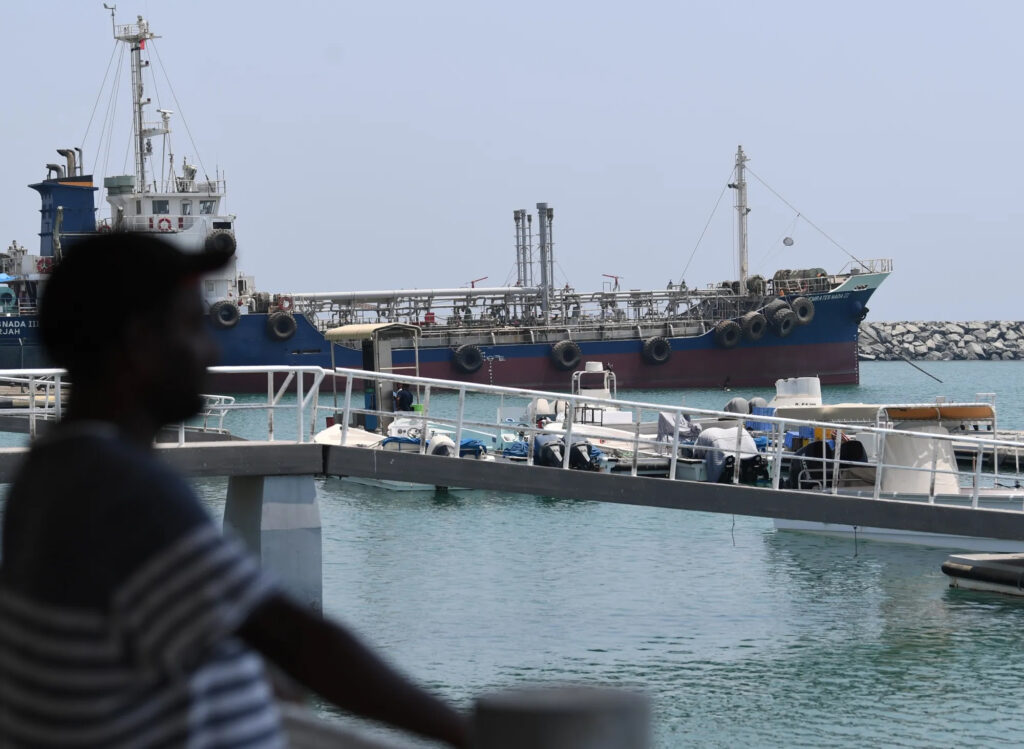By Julian Lee

The proximity to land leaves vessels open to attack from shore-based missiles or interception by patrol boats and helicopters.Photographer: Karim Sahib/AFP/Getty Images
The Strait of Hormuz, a narrow waterway at the mouth of the Persian Gulf, is rarely far from the center of global tensions. A major shipping route that handles around 26% of the world’s oil trade, it’s closely watched for signs of disruption.
Iran has targeted merchant ships traversing the choke point repeatedly over the years, and has even threatened to block the strait in the past.
Tensions rose again in March, when the US renewed military strikes on Iran-backed Houthi rebels in Yemen, who have waged a campaign of attacks on civilian and military vessels in the Red Sea, the region’s other vital waterway.
Washington also threatened to hit Iranian targets in and around Yemen, including ships that provide intelligence and trainers. Such attacks could spark retaliation from Tehran, with shipping through the Strait of Hormuz a potential target.
Where is the Strait of Hormuz?
The waterway connects the Persian Gulf to the Indian Ocean, with Iran to its north and the United Arab Emirates and Oman to the south. It’s almost 100 miles (161 kilometers) long and 21 miles wide at its narrowest point, with the shipping lanes in each direction just two miles wide. Its shallow depth makes ships potentially vulnerable to mines, and the proximity to land — Iran, in particular — leaves vessels open to attack from shore-based missiles or interception by patrol boats and helicopters.
What’s its role?
It’s essential to the global oil trade. Tankers hauled almost 16.5 million barrels per day of crude and condensate from Saudi Arabia, Iraq, Kuwait, the United Arab Emirates and Iran through the strait in 2024, according to data compiled by Bloomberg. The strait is also crucial for liquefied natural gas, or LNG, with more than one-fifth of the world’s supply — mostly from Qatar — passing through during the same period.
The Strait of Hormuz
Tankers haul about 16.5 million barrels a day of crude and condensate through the waterway

When has Iran disrupted shipping?
Iran has used harassment of ships in the Gulf for decades to register its dissatisfaction with sanctions against it, or as leverage in disputes.
- In April 2024, hours before launching a drone and missile attack on Israel, Iran’s Islamic Revolutionary Guard Corps seized an Israel-linked container ship near the Strait of Hormuz. Iran released the ship’s crew the following month, according to trade publication Lloyd’s List. Tehran claimed that the MSC Aries had violated maritime regulations, but analysts pointed to its Israeli ownership connection as a motive.
- When it seized a US-bound tanker in April 2023, Iran said the ship had struck another vessel. But the move appeared to be retaliation for the seizure off Malaysia’s coast of a ship loaded with Iranian crude by US authorities on the grounds of sanctions violations.
- In May 2022, Iran seized two Greek tankers and held them for six months, presumably a response to the confiscation by Greek and US authorities of Iranian oil on a different ship. The cargo was eventually released and the Greek tankers freed. So, too, was the oil on a tanker that Iran said it impounded in January “in retaliation for the theft of oil by the US.”

A man watches ships in the port of Fujairah in the east of the United Arab Emirates.Photographer: Karim Sahib/AFP/Getty Images
Has Iran ever closed the Strait of Hormuz?
Not so far. During the 1980-88 war between Iraq and Iran, Iraqi forces attacked an oil export terminal at Kharg Island, northwest of the strait, in part to provoke an Iranian retaliation that would draw the US into the conflict. Afterward, in what was called the Tanker War, the two sides attacked 451 vessels between them. That significantly raised the cost of insuring tankers and helped push up oil prices. When sanctions were imposed on Iran in 2011, it threatened to close the strait, but ultimately backed off.
Oil traders doubt the country would ever close the strait entirely because that would prevent Iran from exporting its own petroleum. Moreover, Iran’s navy is no match for the US Fifth Fleet and other forces in the region. Commodore Alireza Tangsiri, head of Iran’s Islamic Revolutionary Guard Corps naval forces, said shortly before the MSC Aries seizure that Iran has the option of disrupting traffic through the Strait of Hormuz but chooses not to.
Can the Strait of Hormuz be protected?
During the Tanker War, the US Navy resorted to escorting vessels through the Gulf. In 2019 it dispatched an aircraft carrier and B-52 bombers to the region. The same year, the US started Operation Sentinel in response to Iran’s disruption of shipping. Ten other nations — including the UK, Saudi Arabia, the United Arab Emirates, and Bahrain — later joined the operation, known now as the International Maritime Security Construct. Since late 2023, much of the focus on protecting shipping has switched away from the Strait of Hormuz and onto the southern Red Sea and the Bab el-Mandeb Strait that connects it to the Gulf of Aden and the Indian Ocean. Attacks by the Houthis on shipping entering or exiting the Red Sea have become a greater concern than the Strait of Hormuz. A US-led force in the Red Sea is seeking to protect shipping in the area.

Dhows, fishing boats and cargo ships are seen in the Strait of Hormuz.Photographer: Marwan Naamani/AFP/Getty Images
Who relies most on the Strait of Hormuz?
Saudi Arabia exports the most oil through the Strait of Hormuz, though it has recently been diverting shipments to Europe by using a 746-mile pipeline across the kingdom to a terminal on the Red Sea, allowing it to avoid both the Strait of Hormuz and the southern Red Sea. The UAE can export some of its crude without relying on the strait, by sending 1.5 million barrels a day via a pipeline from its oil fields to the port of Fujairah on the Gulf of Oman.
With its oil pipeline to the Mediterranean closed for more than a year, all of Iraq’s oil exports are currently shipped by sea from the port of Basra, passing through the strait, making it highly reliant on free passage. Kuwait, Qatar and Bahrain have no option but to ship their oil through the waterway. Most of the oil passing through the Strait of Hormuz heads to Asia.
Iran also depends on transit through the Strait of Hormuz for its oil exports. An export terminal at Jask, at the eastern end of the strait, has been largely inactive since it was officially opened in July 2021. The facility offers Tehran a means to get a little of its oil into the world without using the waterway and its storage tanks are slowly being filled with crude. A first supertaker loaded a cargo of Iranian crude at Jask in September.
Julian Lee is an oil strategist for Bloomberg. Previously, he was a senior analyst at the Centre for Global Energy Studies.
Share This:




 CDN NEWS |
CDN NEWS |  US NEWS
US NEWS 


























